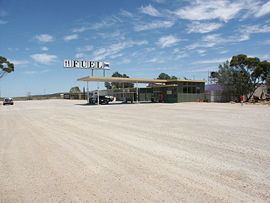Established 1872 Mean max temp Mean min temp Local time Wednesday 12:48 AM | Postcode(s) 6443 Elevation 20 m Postal code 6443 | |
 | ||
Weather 17°C, Wind E at 6 km/h, 92% Humidity | ||
Mundrabilla is a small roadhouse community located on the Eyre Highway in Western Australia, on the Roe Plains (at a lower level and south of the Nullarbor Plain), 67 kilometres (42 mi) west of Eucla and about 20 kilometres (12 mi) north of the Great Australian Bight.
Contents
Map of Mundrabilla WA 6443, Australia
History
Mundrabilla station, the first sheep station in the Nullarbor region, was established by William Stuart McGill (a Scotsman) and Thomas and William Kennedy (two Irishmen) in 1872. Thomas Kennedy died in 1896. McGill's first wife Annie (née Hairkness) died in childbirth in 1879. Annie McGill and Thomas Kennedy are both buried on Mundrabilla Station. McGill remarried Ellen Angel Fairweather of Adelaide in 1889.
Climate
Mundrabilla has a typical arid climate; however it is cooler in summer than much of the Australian desert due to its proximity to the ocean. Despite this, Mundrabilla still holds the record for the equal 4th hottest temperature in Australia, 49.8 °C (121.6 °F) recorded on 3 January 1979.
Present day
Like other locations in the Nullarbor Plain area, the area consists of nothing more than a roadhouse, open 6:00am to 9.30pm each day. The roadhouse includes a small wildlife park with emus, camels and an aviary. Pastoral activities continue in the area, and fragments of a meteorite spread over a 60 km range make it one of the largest meteorite sites in the world.
Mundrabilla Meteor
The largest meteor in Australia known as the Mundrabilla Meteor weighing in 12.192 tonnes was found by two surveyors in Mundrabilla in 1966, forms one half of the "Mundrabilla Mass". The other weighs 5.080 tonnes, where both pieces of the "Mundrabilla Mass" fell to Earth a million years ago.
